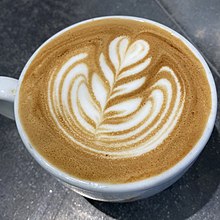This article needs additional citations for verification. (May 2021) |
Latte art is a method of preparing coffee created by pouring microfoam into a shot of espresso and resulting in a pattern or design on the surface of the caffè latte, cappuccino or hot chocolate. It can also be created or embellished by simply "drawing" in the top layer of foam. Latte art is particularly difficult to create consistently, due to the demanding conditions required of both the espresso shot and milk.[1] This, in turn, is limited by the experience of the barista and quality of the espresso machine.


History
editLatte art developed independently in different countries, following the introduction of espresso and the development of microfoam, the combination of crema (which is an emulsion of coffee oil and brewed coffee) and microfoam allowing the pattern; it was initially developed in Italy.[note 1]
In the United States, latte art was developed in Seattle in the 1980s and 1990s, and particularly popularized by David Schomer.[2] Schomer credits the development of microfoam ("velvet foam" or "milk texturing") to Jack Kelly of Uptown espresso in 1986, and by 1989 the heart pattern was established and a signature at Schomer's Espresso Vivace. The rosette pattern was then developed by Schomer in 1992, recreating the technique based on a photograph he saw at Cafe Mateki in Italy.[3] Schomer subsequently popularized latte art in his course "Caffe Latte Art".
Simultaneously, in Italy, Luigi Lupi of Caffè Musetti had a significant impact on the popularization of latte art through instructional videos.[4] Lupi and Schomer collaborated on latte art to improve their technique after meeting online in the late 1990s.[5] Lupi and his refined latte art rose to international recognition during the 2002 Barista World Championship, where he placed 4th.[6]
Chemistry
editLatte art is a mixture of two colloids: the crema, which is an emulsion of coffee oil and brewed coffee; and the microfoam, which is a foam of air in milk. Milk itself is an emulsion of butterfat in water, while coffee is a mixture of coffee solids in water. Neither of these colloids are stable—crema dissipates from espresso, while microfoam separates into drier foam and liquid milk—both degrading significantly in a matter of seconds, and thus latte art lasts only briefly.
Technique
editLatte art requires first producing espresso with crema and microfoam, and then combining these to make latte art. See microfoam: procedure for how microfoam is made; this article concentrates on the latte art once the foam is made.
Before the milk is added, the espresso shot must have a creamy brown surface, an emulsion known as crema. As the white foam from the milk rises to meet the red/brown surface of the shot, a contrast is created and the design emerges. As the milk is poured, the foam separates from the liquid and rises to the top. If the milk and espresso shot are "just right", and the pitcher is moved during the pour, the foam will rise to create a pattern on the surface. Alternatively, a pattern may be etched with a stick after the milk has been poured, rather than during the pour.
Some controversy exists within the coffee community as to whether or not there is excessive focus on latte art amongst baristas. The argument is that too much focus on the superficial appearance of a drink leads some to ignore more important issues, such as taste.[7] This is especially relevant with new baristas.
See also
editMedia related to Latte art at Wikimedia Commons
Notes
edit- ^ David Schomer (Schomer 1994) describes pitcher-shaking in latte art as "quite standard in the world of Italian espresso preparation", indicating that it established in Italy by this time.
References
edit- ^ Imam, Febri. "Latte Art Guide". CoffeeGeek. Archived from the original on 2011-08-02. Retrieved 2011-10-26.
- ^ Bonné, Jon (May 9, 2003). "Meet espresso's exacting master — Food Inc". NBC News, MSNBC. Archived from the original on October 17, 2014.
- ^ Schomer (1994). "Latte Art 101". CoffeTalke. espressovivace.com. p. 13.
- ^ Latte art productions by Luigi Lupi (Caffé Musetti), retrieved 2022-11-04
- ^ Porte, Café (2021-09-24). "History of Latte Art or Decorated Cappuccino". Porte. Retrieved 2022-11-04.
- ^ "Luigi Lupi". Revista Fórum Café. Retrieved 2022-11-04.
- ^ "Anti Latte Art". CoffeeGeek. Retrieved 2011-10-26.